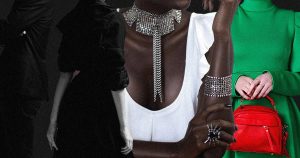How marketers are bridging the gap between millennials’ and Gen Z’s love of upscale goods and desire for economy
 Adweek; Getty Images
Adweek; Getty Images
Millennials and Gen Z walk a fine line when making decisions between whether to buy affordable, fast fashion options that may not make it through more than a handful of wash cycles, and items that may cost more upfront but last longer and stay out of the world’s landfills.
Environmentally aware and well educated on the value of sustainability, these younger consumers view fashion through a different lens than their predecessors, and marketers have taken notice.
These realities are pushing clothing makers to rethink their manufacturing process, how they go to market, and even reusing and recycling their products, with sustainability top of mind. It’s also encouraging companies to emphasize the pre-buying process and offer try-before-you-buy services to generate less waste.
In a world where acquiring a few different sizes and colors of the same item and discarding what didn’t work is the norm, these smart fashion brands are focused on Coco Chanel’s mantra of “less is always more.”
Blurred lines
For now, it looks like younger consumers are divided into two camps, although the lines are blurring.
The first group enjoys purchasing from retailers like Shein for its low-cost and trendy options, while the second would rather invest a bit more in luxury goods that could last a lifetime (and even become inheritable, heirloom goods for the next generation).
To meet these various needs, some companies are serving up luxury that’s attainable for a wider group of potential customers. Gucci’s experimental Vault ecommerce shop, for example, has the option to buy now, pay later through Affirm, putting bags, accessories and other goods within reach for younger buyers. Through Vault, the company offers a curated selection, an interactive virtual experience and the written assurance that each order is “100% carbon neutral.”
Rent the Runway is another company whose business model aligns well with what younger generations have come to expect from their fashion retailers.
The ecommerce platform allows users to rent, subscribe and buy designer apparel and accessories. And while the company was founded in 2009, long before Gen Z began demanding that the world pay more attention to environmental sustainability, its wide variety of styles appeals to everyone from the high schooler looking for an expensive prom dress to the executive in need of a full suite of professional attire (but who can only be seen in those outfits one or two times at most).
Like Gucci, Rent the Runway appeals to millennials and Gen Z’s desire for high fashion at a price they can afford. It also supports good reuse and recycling of clothing and accessories through a “borrowed” model that platforms like Rebag, The RealReal and thredUp also use to successfully resell items that could otherwise be headed to a landfill. The approach truly exemplifies the “one man’s trash” idiom, and it appears to be working.
Secondhand fashion drives growth
Secondhand fashion is also bringing the younger generations to luxury goods. They’re experiencing it, enjoying it and finding the quality they’re seeking.
As more millennial and Gen Z consumers are introduced to luxury brands, they’re also appreciating those brands’ sustainability. This will surely increase their love for luxury items and lead them to outlets like Vault, which we’ll likely see more of in the near future.
While fast fashion has its place, luxury brands are coming up with new ways to meet younger consumers where they are, both in terms of financing and social responsibility. They meet these buyers’ fashion needs, developing sustainable approaches that hit those customers where their hearts are.
“As more millennials and Gen Z shoppers come into their peak purchasing power, luxury brands have an opportunity to capitalize on this growing wealth,” according to ecommerce solutions site Scalefast, noting that younger shoppers have specific buying preferences that brands have to factor in—from sustainability to personalization to social media influence—and adapt to if they want to provide the ecommerce experience that these generations expect.
This purchasing power is digitally driven and reacts to digital content and messaging. A recent eMarketer report highlighted that “Gen Z is getting older and steadily moving toward becoming the most digitally connected generation. In 2024, U.S. Gen Zers will surpass millennials in regular internet use, and they’ll do the same with smartphone penetration in 2026.”
The eMarketer report also addresses the purchasing power of this younger generation, which will only continue to grow. “In 2024, when U.S. Gen Z internet penetration will jump to 99.1%, Gen Zers will be between 12 and 27 years old. Millennials, who will be fully into adulthood (ages 28 to 43), will stagnate at 97.4% penetration.”
And these younger generations are having a significant impact on older consumers too. “These trends are not limited to millennials and Gen Z shoppers. Their preferences continue to influence older generations,” Scalefast added. “This means luxury brands should cater to younger buyers sooner rather than later to avoid missing out on the significant growth opportunities coming by the year 2035.”





